ANS 313 Exam 2
1/125
There's no tags or description
Looks like no tags are added yet.
Name | Mastery | Learn | Test | Matching | Spaced |
|---|
No study sessions yet.
126 Terms
This essential amino acid is generally first limiting in cereal grains. If corn or wheat had more of it, they would be a better protein source
lysine
The amino is essential, neutrally charged, “aromatic”, and has one of the most complicated structures of any AA. It is also one of the first to be destroyed when a feedstuff is heated too much. It is used as a substrate to make the neuropeptide serotonin
tryptophan
what is the name of the compound excreted in urine by mammals to get rid of excess body nitrogen?
urea
This is a first choice for a protein supplement for almost any farm animal in Michigan
Soybean meal
This nonprotein nitrogen source can be used by microbes to make protein. Thus, it is often fed as a supplement to cattle when they are fed high-grain diets.
urea
As as young animal ages and grows, the ratio of protein to energy in its diet _____ because the context of tissue gain becomes more fat and less lean.
decreases
When the supply of amino acids in a diet perfectly matches the requirements of the animal, the dietary protein is considered to be an _____ protein. Protein excretion will be minimized if the right amount of total protein is fed
ideal
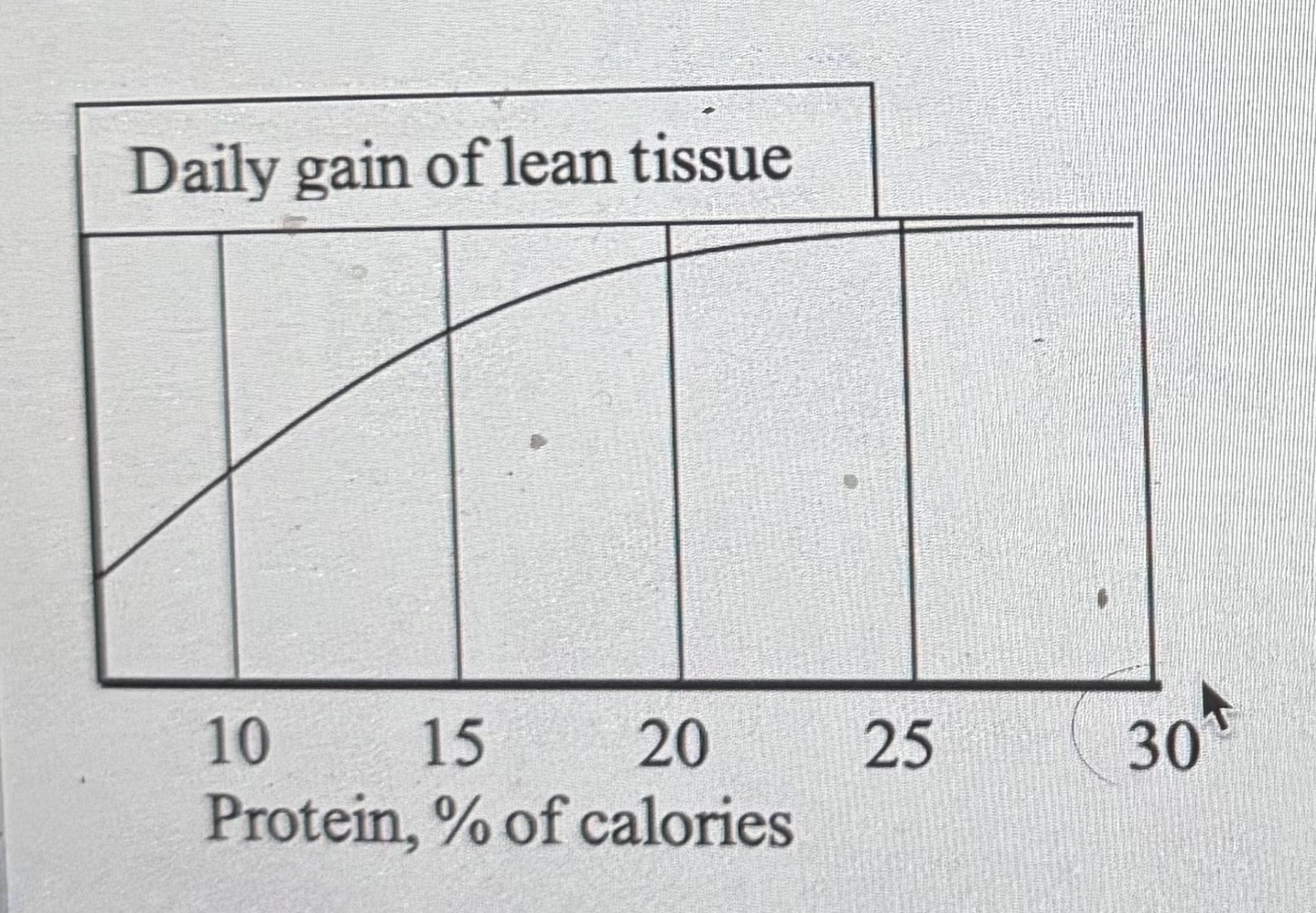
Twenty pups of similar age and genetics are fed one of five diets with equal energy density but varying concentrations of protein. This figure shows the daily gain of lean tissue on the vertical axis in grams per day plotted against protein as a % of calories in the diet on the horizontal axis. At which of the following levels would the puppies use protein most efficiently?
15%
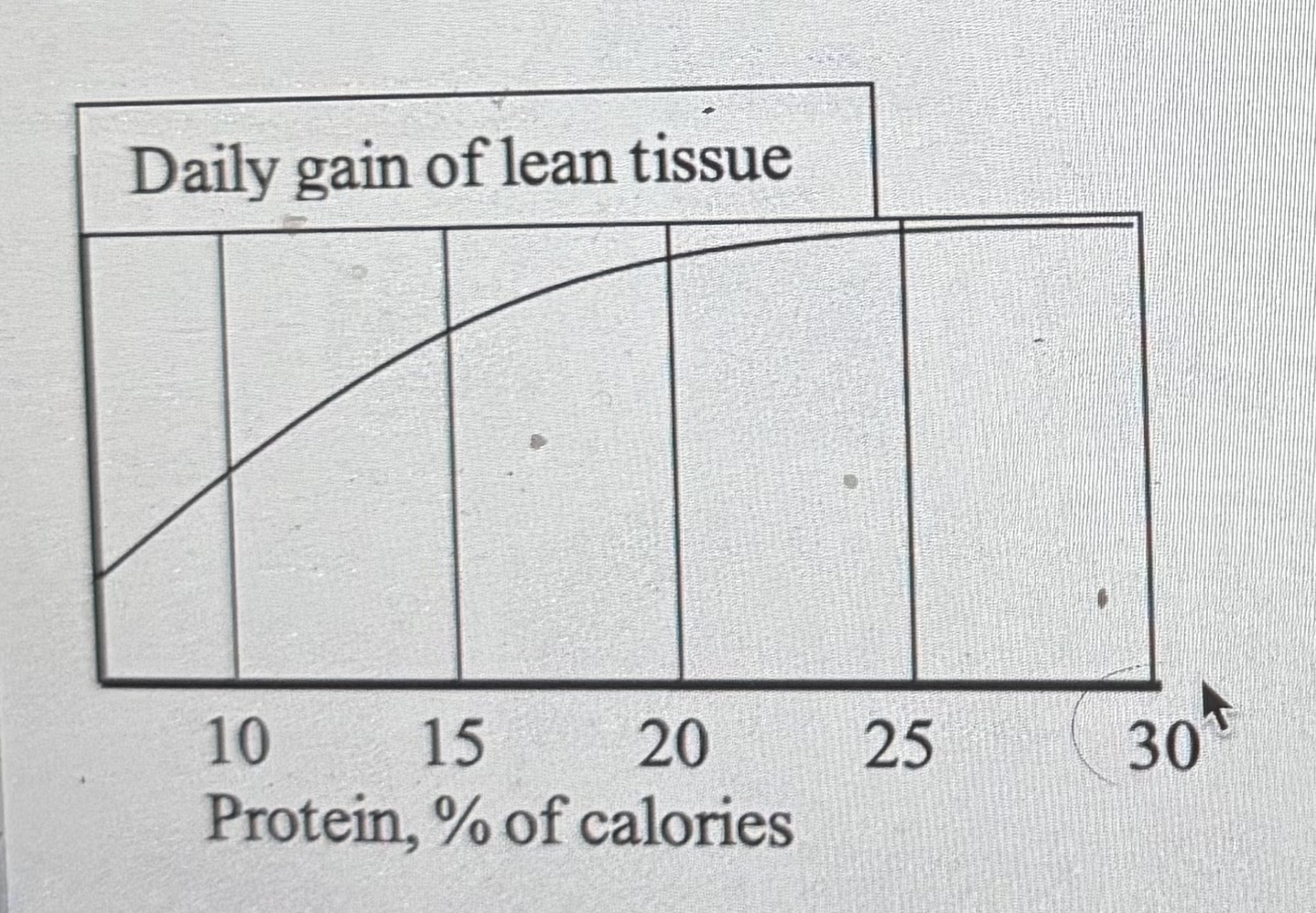
Twenty pups of similar age and genetics are fed one of five diets with equal energy density but varying concentrations of protein. This figure shows the daily gain of lean tissue on the vertical axis in grams per day plotted against protein as a % of calories in the diet on the horizontal axis. This figure demonstrates what important principle in animal nutrition?
Law of Diminishing Returns
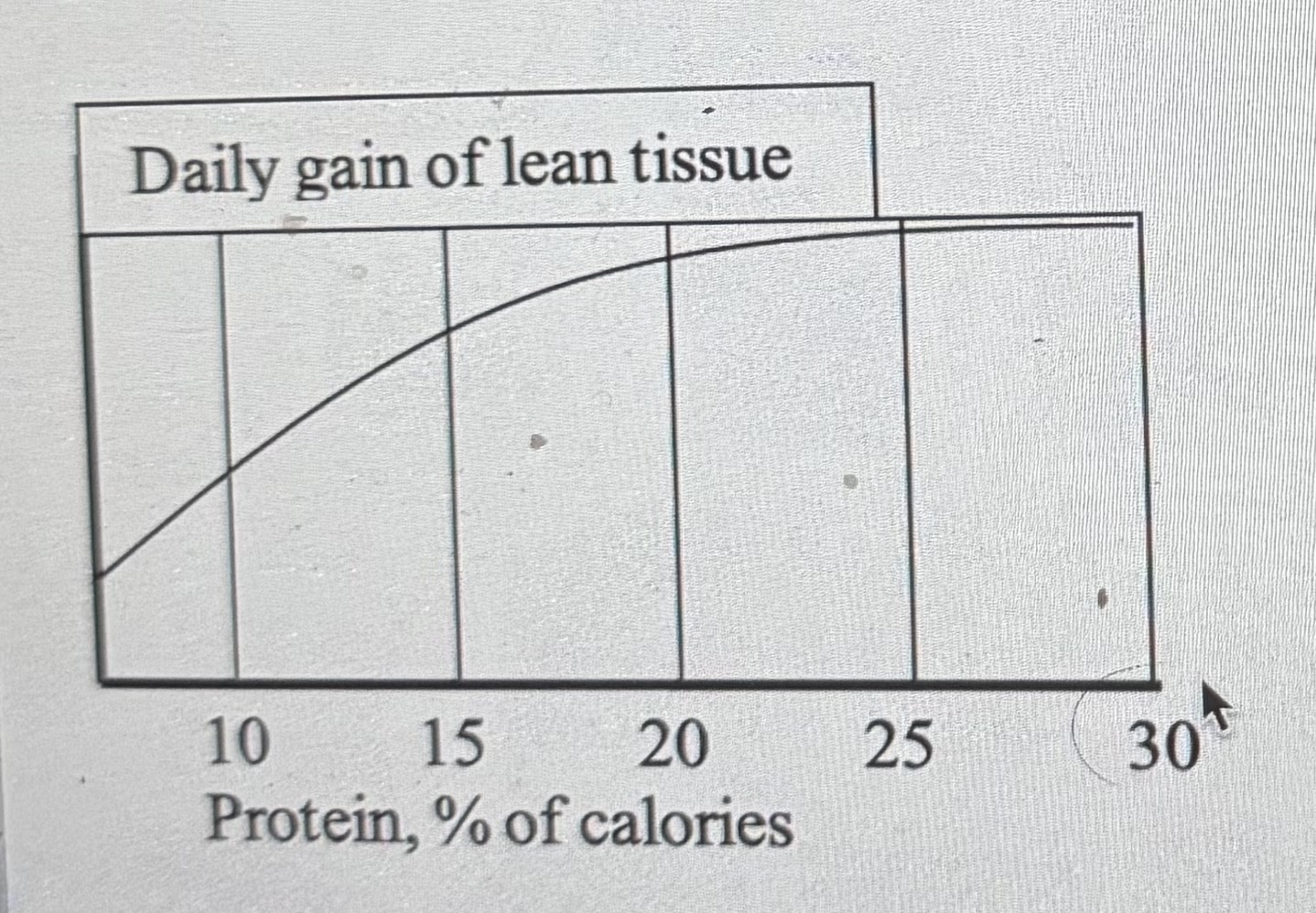
At which level would be considered to be the “protein requirement”?
25%
A bomb calorimeter is used to measure the gross energy content of soybean oil. What is the likely result?
Any of these:
9.5 calorie/mg
9.5 kcal/gram
9.5 calories/gram
9.5 Mcal/kg
What compound is responsible for most energy lost in the urine of a cow?
Urea
Animals that grow faster or produce more milk per day are more efficient. They need less feed and land resources per pound of product and produce less waste per pound of product. Name the general principle of this phenomenon.
Dilution of Maintenance
This compound accounts for most of the energy lost as gas energy in a llama
methane
within an animal’s thermoneutral zone, it maintains ideal body temperature with no extra metabolic work by:
regulating blood flow in the skin
When a female ferret is fasted, its thermoneutral zone is 75 to 90 degrees F. What might it be if it were lactating?
60 to 80 degrees
The nutrition label for a bag of fried white rice states that a 1-cup serving has 1g of fat, 4g of protein, and 41g of carbohydrates. How many calories do you expect it will contain?
189
Amount x physiological fuel values added together
41 × 4 = 164
4 × 4 = 16
1 × 9 = 9
164 + 16 + 9 = 189
A kitten retains 10g of protein and 6g of fat in a month. how much retained energy (kcal) would this equal?
110
10 × 5.65 (retained protein value) = 56.5
6 × 9.5 (retained fat value) = 57
56 + 57 = 113.5 (within 10% of 110)
When a lamb is fasted, its heat production is 950 kcal per day. What is its Net Energy for Maintenance requirement when it eats 2500g of food per day and grows 400g/day?
950
NE for maintenance = “fasting heat production” can be determined by measuring heat production when an animal is not eating for several days.
When a pony eats 6.0kg of food per day, it does not gain or lose body mass. The food has an ME value of 2.2 Mcal/kg. How much total heat is the pony producing per day?
6 × 2.2 = 13.2
What is a protein?
Polymers of α-L-amino acids (AA)
Amino acids have amino group and carboxyl group
Proteins contain 20 unique AA. The R group or carbon skeleton is what makes each one unique.
D-AA are not used unless converted to L
AA analogs: amino group replaced by hydroxyl or keto group. For some AA, the body can convert these to the respective AA.
Peptide bond: AA1 amino group with AA2 carboxyl group.
Upon hydrolysis (H2O added),
free AA are released
Structures of Proteins
Primary structure = AA sequence
sequence is a function of genetic code, not diet
if one AA is missing → no protein
3-dimensional structure - determined by bonds (such as disulfide bridges) between cysteines or interactions of hydrophobic or hydrophilic regions. These may include interactions with other molecules or minerals.
Structure determines function of all proteins, including regulatory, blood, and contractile proteins.
Digestion and metabolism of proteins and AA
Digestive enzymes hydrolyze proteins to AA and di/tri peptides in small intestine
Protein is absorbed about half as free AA and rest as dipepetides and tripeptides
Eventually all become free AA
Order of presentation to body tissues
lumen of gut
→ intestinal lining
→ liver
→ systemic circulation
Intestinal lining is only tissue in adult that grows like tissues of young animal
AA are not stored in the free form. Most body protein is in skeletal muscle; this is not really “stored” protein, as it has a function. However, it can serve as a reservoir of AA when needed.
Skeletal muscle is ~20% protein and ~80% water
Gross Energy value of protein = 5.65 kcal/g protein
The 20 Amino Acids used as protein building blocks
A. Simple neutral aliphatic AA
1) glycine (gly) 2) alanine (ala)
3) serine (ser) 4) threonine (thr)
B. Branched-chain neutral aliphatic AA - play a role in regulating protein synthesis
5) valine (val) 6) leucine (leu) 7) isoleucine (ile)
C. Aromatic neutral AA – “large neutral AA”
8) phenylalanine (phe) 9) tyrosine (tyr) 10) tryptophan (trp)
D. Sulfur-containing AA
11) cysteine (cys) 12) methinione (met)
E. Acidic AA – major fuel source for gut tissues
13) aspartic acid, aspartate (asp) 15) glutamic acid, glutamate (glu)
14) asparagine (asn) 16) glutamine (gln)
F. Basic AA
17) lysine (lys) 18) histidine (his) 19) arginine (arg)
G. Imino acids: 20) proline (pro)
**highlighted ones have other known functions in addition to being protein building blocks
What is often the most limiting amino acid for animals?
methionine
Other Amino Acids
hydroxyproline - makes collagen tough
taurine - a S-containing AA, not a building block for protein, but is a free-AA found only in animal products. It has multiple functions and probably should be considered a vitamin. - Very important in cats !!
ornithine - part of urea cycle, important for getting rid of extra N
citrulline - part of urea cycle, important for getting rid of extra N
cystine - 2 cysteines linked together
- resulting cross-links are important for 3d structure of proteins
Essential Amino Acids
indispensable and required in the diet
PVT TIM HALL
Phe, val, thr, trp, ile, met, his, arg, leu, lys
Non Essential Amino Acids
dispensable amino acids
required to make proteins, but they usually can be synthesized in adequate amounts by body tissues if the amino group is provided by other AA
if you ate only essential AA at requirements with nonessentials, you would use lots of essentials to make nonessentials
most feeds contain plenty of the nonessential AA
AA Nutrition: Exceptions to the 10 Essential
1) Sulfur AA: sometimes we consider the total S-AA requirement instead of just methionine. 50-100% of S-AA reqt can be supplied by methionine, rest by cystine
2) Phe + Tyr: 50% of Phe requirement can be supplied by Tyr ("Tyr spares Phe")
3) Arg: usually adult mammals do not require Arg because they have urea cycle, but arg is essential to poultry, which have no urea cycle
4) His: although considered essential, adults of some species can synthesize adequate amounts
5) Pro: young growing poultry may require dietary Pro, so often added as cheap insurance -- high in connective tissue
6) Gly: often added to poultry diets -- important for feathering
7)Tau: some animals require taurine, esp. cats. Note taurine is not used in protein synthesis. It is more like a vitamin.
Law of the Minimum
formulated by Karl Sprengel and Justus von Liebig ~1840
Growth is controlled not by the total amount of resources available, but by the scarcest resource (limiting factor).
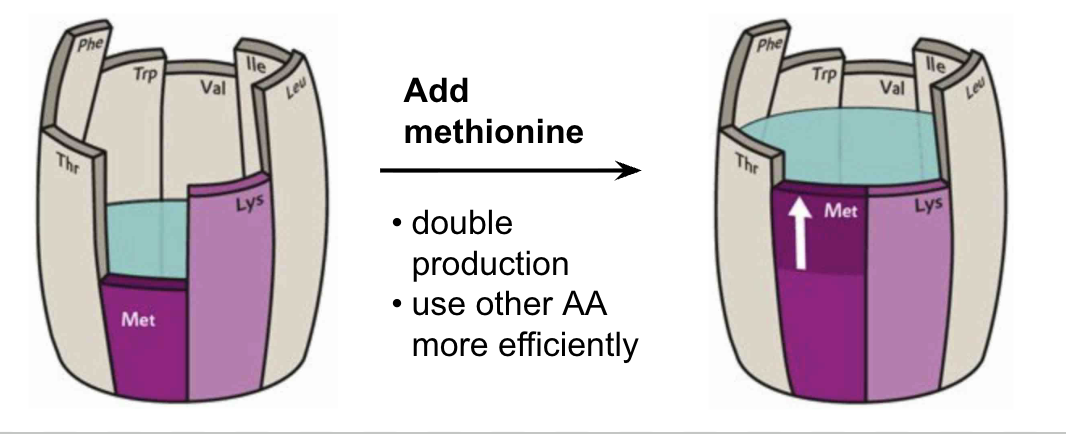
The limiting AA
“Limiting AA” is AA least available relative to its requirement.
- add more of the others but not much response
- sometimes the “most limiting” AA is not actually limiting production
Limiting AA depends on species, physiological state (growing, milking), and base feedstuffs (i.e., corn-soy) in diet.
- AA profile needed is a function of genetic code, not diet
Most limiting AA is lysine for swine fed corn/soy diets, but methionine for poultry.
This limiting AA concept is the basis for the "Protein Quality” of a feedstuff. Each feedstuff has its own most limiting AA.
When a diet matches the profile of AA needed perfectly, the animal is being fed its Ideal Protein = Perfect AA blend
Why feed an “ideal protein”
Proper pattern of absorbed essential AA will help enhance protein production and maximize efficiency of protein use.
The proper AA pattern is the “ideal protein”/
Add limiting AA and reduce excess AA in common feeds
Lower total diet protein but get same productivity.
Nutritional quality of dietary protein
%CP is a crude measure of protein. It is not all true protein, it says nothing about digestibility, and nothing about AA profile.
Underlying determinants of protein quality
1. Essential AA profile
- If one EAA is lacking, the quality is zero.
However, this is only true if the protein is fed by itself.
Gelatin has virtually no trptophan, so very poor quality
2. Bioavailability of AA
a. only those AA that are absorbed are useful
b. varies by protein source
- hair has great EAA profile, but it is not digestible so not available
c. varies by processing - esp. important for dried products
- heating - often decreases availability
Measures of protein quality
1. Biological value (BV) = Nretained / Nabsorbed
- inversely related to urinary N
- high BV → well balanced absorbed AA patten → low urinary N excretion
- low BV → excess AA will be deaminated → high urinary N excretion
2. Net Protein Value (NPV) = Nretained / Nconsumed = BV x digestibility
- considers pattern of available AA relative to requirements
will always be equal to or lower than BV
Example calculations
BV Digestibility NPV
Milk protein 90 90% 81
Keratin 80 0-10% 0-8
Gelatin 0 100%. 0
Ranking of protein sources
Excellent (NPV = 90; BV = 100) NPV
Animal proteins (80-90) - lower if dried
Legume leaves 75-80
Meals of oilseeds 50-60
Cereal grains (lysine deficient) 40-60
Roots and Tubers 20
Worthless as a protein source (NPV = 0)
Protein quality and quantity and efficiency of protein use
Protein gain (N retention) increases as a growing animal is fed a higher %protein in its diet, but the percent of feed N retained decreases—efficiency of protein use decreases as we approach maximum protein gain per day.
Protein is used most efficiently when it is the limiting nutrient. To assess the quality of a feed protein, protein must be limiting.
The protein quality of a mixture of protein sources will be greater than the average of the individual sources. Thus, several proteins of lower quality can be blended to give a diet of higher quality.
- Example: NPV
Soybean meal ≈60
Corn grain ≈50
Corn-soy mix ≈75
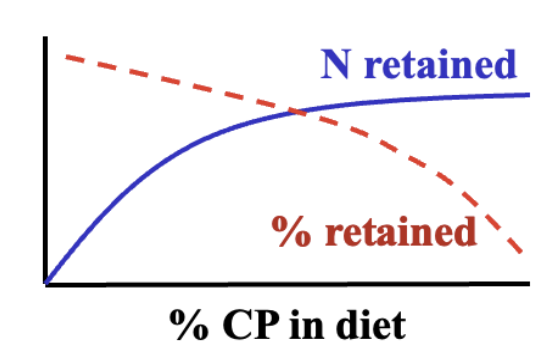
Protein Nutrition = AA Nutrition
A better way to meet protein requirements is to meet the requirements of each individual AA.
Feeding enough protein means feeding enough of each essential AA
This requires accurate information about:
The animal’s requirements for each AA
the concentration of each AA in each feed ingredient or analysis of the total diet.
In addition, animals need N to make nonessential AA so total protein is still useful information. Thus, we consider %CP as well as % of each essential AA.
Problems with balancing for AA
The big problem: Feeds vary in AA content, but we don’t usually measure AA content.
The limiting AA concept is too simplistic.
Animals do need some AA above just the essentials to make the nonessentials. (However, most feeds have plenty of nonessential AA)
For some animals, we don’t really know the AA requirements.
For ruminants, AA are mostly broken down in the rumen.
So what to do? Balance for AA when we can, and:
Feed at least 2/3 of total crude protein requirement
Feed several different types of proteins
Make sure the protein feedstuffs are good quality and “normal”
Monitor how the animals are responding to the diet.
Circulating AA and their fate
1/3 of the AA in blood are from absorption and 2/3 are from body protein breakdown. Thus, effects of diet on blood profile are hard to detect.
Fate of AA taken up by cells: Because AA are not stored as free AA, they are either:
1. incorporated into protein
2. catabolized
C skeleton is:
oxidized to generate ATP
converted to glucose (gluconeogenesis)
converted to a fatty acid (lipogenesis)
used in a combination of these
N group is waste product that must be removed.
Protein Catabolism
Step 1 is to replace the amino group with a keto group using deamination or transamination. The N must be excreted.
Step 2 is to oxidize the keto acid to obtain energy
Removal of excess NH2
cannot oxidize N, must get rid of amino N
Waste forms of amino N
1) urea: mammals
- urea formed in liver and excreted by kidney into urine
- urea formation and excretion reduces the energy value of protein as a metabolic fuel (hence protein has about the same ME value as carbohydrate)
- urea cycle lots of excess N → high BUN
> 20 mg/dl → fertility problems?
2) uric acid: birds
3) ammonia: fish
Protein Turnover
body proteins of the gut, skeletal muscle, and other tissues are being degraded. Some of these AA are deaminated so they must be in the diet.
Whole Body protein turnover
Protein synthesis
Proteolysis = protein degradation or breakdown, or mobilization
Protein accretion = net protein synthesis
= synthesis – breakdown
= N balance x 6.25
Note: accretion is also called gain, balance, net deposition, and net synthesis
a. Growing animal: accretion is positive
b. Adult animal: accretion is generally zero
c. Lactating animal: accretion is often negative in early lactation
About 90 kcal of ATP are needed to synthesize 100 g protein.
Nitrogen digestibility, balance, and efficiency.
N digestibility = N digested / N intake
N balance = N intake – N out
N efficiency = N captured / N intake
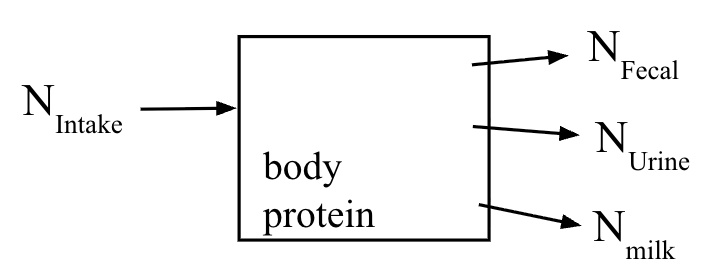
Efficiency of capturing dietary N (or recovering dietary N)
a. Example growing animal:
Intake N = 100 g
Captured N = Retained N = 20 g
Efficiency = 20%
Protein efficiency seldom exceeds 20% in growing animals, but can be ~50% in young growing poultry
b. Example lactating animal
Intake N = 100 g
Captured N = 30 g (28 g milk N, 2 g retained N)
Efficiency = 30%
Protein efficiency seldom exceeds 35% in lactation
Protein to energy ratio: more important than %CP
If the energy density increases, the density of CP and AA (and all other nutrients) should increase proportionally.
Animal may eat less, so need more nutrients per unit of food.
Animal may grow faster, so need more AA to make body proteins.
If the energy density decreases, the density of CP and AA (and all other nutrients) should decrease proportionally --- unless you are feeding for weight reduction.
Animal may eat more, so need less nutrients per unit of food.
Animal may gain less weight, so need fewer AA to make protein.
Protein to energy ratio
g CP /Mcal (or g lysine/Mcal) is more important than g CP /kg DM (or g lysine /kg DM)
The requirement for protein relative to energy:
decreases with age (highest in young growing animals)
increases with pregnancy and lactation
does not change with exercise
increases if feeding a carbohydrate-free diet
increases with dietary energy restriction for weight loss
decreases outside thermoneutral zone
can be lower if feeding to replete body fat in a thin animal
Meeting the requirement for Metabolized Protein (MP)
Two sources of protein for absorbed amino acids
a. Rumen-undegraded protein
b. Microbial protein
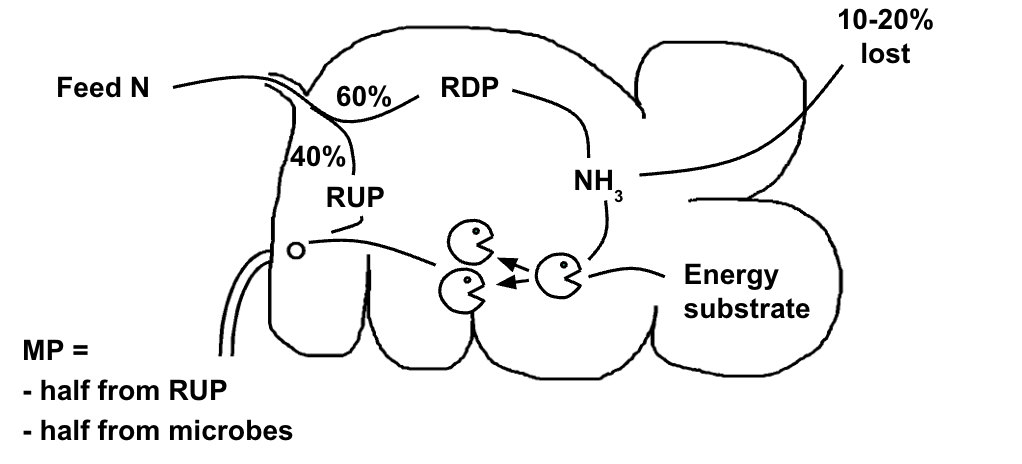
Microbial cell (protein) production
Substrates needed
1) Fermentable Organic Matter: fiber, starch, sugar, protein
2) N sources: ammonia, amino acids
Max microbial yield occurs when the amounts of available energy and N substrates are matched. If energy substrates are limiting, excess N cannot be used.
Microbial protein production (MiCP) is related to:
feed intake More feed → ↑ MiCP
Availability of N < 10% RDP → ↓ MiCP
Fermentable organic matter More FOM → ↑ MiCP
Carbohydrate fermentation rate Faster fermentation → ↑ MiCP
Rumen pH Low pH → ↓ MiCP
Ruminant Protein Nutrition: N Cycle
Costs and benefits of N recycling
Low N intake: use recycled N as a N source for microbes
High N intake: energy is "wasted" to keep the cycle going
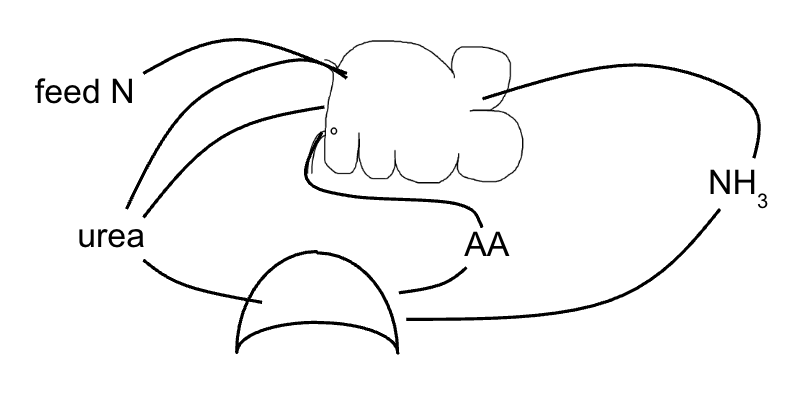
Strategy to meet protein requirements
Step 1 is to maximize microbial protein synthesis.
NPN (non-protein nitrogen) supplements might be useful.
Step 2: supply extra rumen-undegraded protein if needed.
Almost all feeds have some RUP, so first estimate total MP provided from diet.
Some feeds are especially high in RUP. They are expensive but should be fed if the rumen microbes cannot meet the animal’s MP requirement
RUP must be intestinally-digested to be useful.
Step 3: consider using a rumen-protected AA supplement. They are usually expensive, but might be worth it. Microbial protein is high in lysine.
No nutrition model can accurately predict when RUP or AA supplements will be beneficial.
A good general rule is to provide a variety of protein supplements to animals that have high protein requirements.
Special protein considerations for cats
Cats have a high maintenance (2X) requirement for protein compared to dogs; their protein requirement for growth is 1.5 times that of dogs. The enzymes that catabolize amino acids in cats are always active, even if they are fed a low protein diet. One reason for this may be that cats use AA as the primary source for glucose, especially glucose that will be stored as glycogen. A cat would suffer from protein malnutrition even when fed a diet adequate in protein for most other animals.
Cats have an absolute dietary requirement for arginine for optimal function of the urea cycle. Cats fed diets devoid of arginine rapidly exhibit hyperammonemia and will exhibit signs of ammonia toxicity.
Cats have a high requirement for taurine. Taurine can only be supplied by animal products or supplements, and cooking destroys much of the taurine. One of the first signs of inadequate taurine is impaired vision.
You have two growing chickens. You feed the same diet, but one eats at 1.5x Maintenance and the other at 2x Maintenance. You feed them both until they reach a market weight of 7 pounds. Which chicken eats the most, has the lowest feed efficiency, and costs the most to get to the 7-pound market weight?
Chicken fed at 1.5x
You have two growing chickens. You feed the same diet, but one eats at 1.5x Maintenance and the other at 2x Maintenance. You feed them both until they reach a market weight of 7 pounds. Which chicken would have the lowest thermoneutral zone on the third day of the study?
Chicken fed at 2x
This part of the energy scheme is wasted energy for an animal outside in warm weather, but it is useful if the weather is cold.
Heat Increment of Feeding
When the weather is hot and humid, farmers often cool their lactating cows with fans. If they don’t, the cows will likely eat
less, as a way to reduce heat production and thereby heat stress.
Metabolic body weight (body weight in kilograms to the ¾ power) is useful in animal nutrition because we use it to calculate an animal’s energy requirement. Specifically, it is used to calculate the requirement for this part of the energy scheme.
Net Energy for maintenance
The breeder tells you to feed a diet that is 30% protein until he is 6 months old, assuming the diet is 3.5kcal/g. You decided you want to feed a high-energy feed that is 4.2 kcal/g. You want to follow the breeder’s advice, What & protein should the diet be?
30/3.5 = 8.57
8.57 = 4.2 = 36
When you feed your puppy 200g of food per day for a week, his body weight does not change. If you feed him 400g of food per day, he gains 700g in a week. Your nutrition advisor tells you to assume this is a gain of 500kcal per day. What is the apparent Net Energy for Gain value of this food?
500(gain of kcal per day)/200(difference between 200 and 400g) = 2.5
A young lamb gains 100g of muscle and 20g of body fat per day. How many kcal of retained energy is this?
100 × 1.1 = 110
20 × 9.5 = 190
=300
OR
20 g protein x 5.7 kcal/g + 20 g fat x 9.5 kcal/g = 304 kcal = 300
1st Law Thermodynamics: Conservation of Energy
total energy of a system and its surroundings is constant
types of energy: chemical, kinetic, thermal
2nd Law of Thermodynamics: Decreasing Value of Energy
the entropy of a system and its surroundings always increases
the free energy (usable energy) always decreases
Reactions must be thermodynamically favorable to proceed.
Thermodynamics
Calorimetry: measurement of heat evolved or absorbed in reactions
A thermodynamically unfavorable reaction can be converted into a favorable one by coupling it to the hydrolysis of ATP.
Respiration: the basis for life, provides ATP to fuel growth, lactation, work, and body maintenance
C6H12O6 + 6 O2 +36 ADP + 36 Pi → 6 CO2 + 6 H2O + 36 ATP
Anabolic reactions: peptide bond
36 ATP catalyzes the formation of ~ 8 peptide bonds
The conventional scheme of energy flow
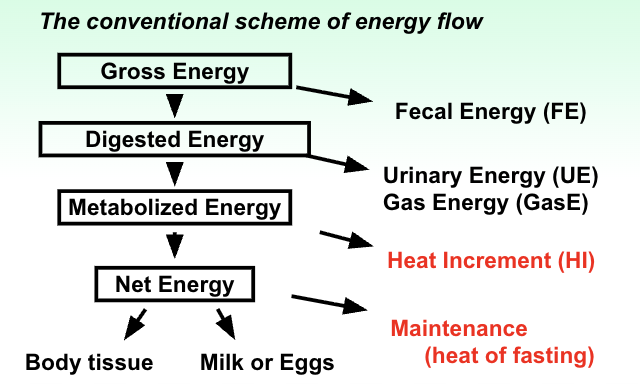
Gross Energy (GE)
Gross energy of feed consumed
energy value of feed if it is completely oxidized (measured in the combustion chamber)
many compounds contain oxidizable or combustible energy, but only some can be used to fuel metabolism
Fecal Energy (FE)
feces contain organic compounds that can be oxidized
some of these compounds are food that was not digested
some are compounds of body origin - cellular debris, digestive enzymes, excreted waste products, gut microbes
Gas energy (GE)
methane = 13kcal/g
Urinary Energy (UE)
Urea = 2.5 kcal/g
some is of food origin - from unbalanced AA profile
some is of body origin – from normal body protein turnover
Heat Increment of Feeding
the increase in total heat production that results from being in a fed-state compared to a fasted-state
heat of fermentation - microbial work - this energy was never actually absorbed across the gut wall
heat of nutrient metabolism
1) physical work of eating and digesting nutrients
2) biochemical work of digesting and metabolizing nutrients
digestion and absorption of nutrients
metabolism of the intestinal mucosa and liver as they process nutrients
product formation – proteins and fats in muscle or adipose tissues or in the mammary gland. Making these products requires ATP!
HI as a % of ME is different for different types of feeds based on their nutrient content
Net Energy (NE) for maintenance
net energy available for maintenance and production
a. NE for maintenance - all lost as heat -- “fasting heat production”
1) basal metabolic rate (BMR) = minimum energy cost of the automatic body processes compatible with life
∙ respiration (diaphragm work)
∙ circulation (heart work)
∙ waste formation and excretion (liver and kidney)
∙ nervous function
∙ osmotic balance of all tissues: Na/K pump
∙ maintenance protein turnover: replacing old proteins
activity increment - minimum voluntary activity
~10% of BMR
3)thermoregulation (skin, diaphragm)
Net Energy for Production
1) Products: actual caloric value of the compounds produced
∙ Retained energy = the energy in body tissues
⇒ includes energy of proteins as well as that of fats
⇒ 1 g muscle @ 20% protein @ 5.7 kcal/g = 1.1 kcal/g
⇒ 1 g adipose @ 100% lipid @ 9.5 kcal/g = 9.5 kcal/g
∙ output products
⇒ Lactation energy = the energy of secreted milk
⇒ Conceptus energy = the energy of the gravid uterus
⇒ Ovum = the energy of eggs
⇒ Wool, hair, feathers
Physical work (voluntary activity): kinetic energy - most ends up as heat
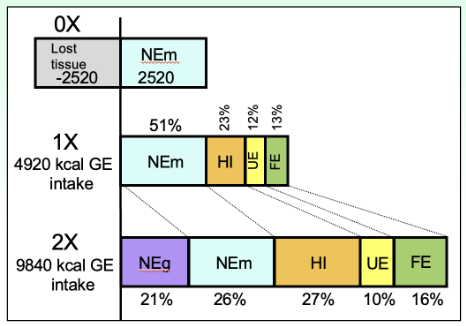
Energetics and Level of Intake
What % of GE is lost as heat at 1X and 2X?
1X: 51 + 23 = 74% 2X: 26 + 27 = 53%
Comparing 2X to 1X:
Why is %FE higher?
Lower digestibility as passage increases
Why is %UE lower?
More the N is captured so smaller percentage is lost as UE
Why is %HI higher?
More metabolic work in needed to process nutrients for muscle and fat gain
Efficiency of converting ME to NEg
ME is converted more efficiently to NE for maintenance than to NE for gain
Below maintenance intake, body tissue is being lost to supply energy for maintenance. As the animal eats food, it loses less tissue energy per day; once it eats above its maintenance requirement, it gains tissue energy per day. The steeper slope below maintenance indicates that each gram of food provides more NE for maintenance than it does for gain once maintenance requirement has been met. NEg is usually about 60-70% of the NEm value for a feed.
the ratio of NEg to NEm is different for different feeds: fat > starch > fiber
Metabolic Body Size and maintenance requirements
Maintenance requirement is related to metabolic body weight (BW.75)
Basal Metabolic Rate is related to BW.75
The idea is that energy requirements are related to body skin surface area
smaller animals typically can do more work per unit weight, are more active, and have faster heart rates. They require less drug per unit weight and consume more food per unit weight.
General equation for Fasting Heat Production in kcal = 70 (kg BW).75
Thermoneutral Zone
the range of ambient temperatures in which an animal can maintain its normal body temperature by physically altering heat dissipation from the skin through altering blood flow and sweating without expending extra chemical energy.
Within the “thermoneutral zone”, an animal can maintain thermal equilibrium by mechanisms that do not require extra metabolic work. Outside this zone, extra work (extra heat production) is required to keep the body at the right temperature. If an animal eats a lot, it produces more heat increment, and thus its thermoneutral zone shifts down – it is less likely to be cold-stressed and more likely to be heat stressed.
Thermoregulation when fasting
Maintenance requirement and environmental temperature.
in cold weather, maintenance requirement increases to keep body warm
in hot weather, maintenance requirement increases to dissipate heat
Thermoregulation and productivity
Sources of Heat Production related to thermoregulation.
Basal Heat Production (NEm) when the animal is within the Thermoneutral Zone for Fasting.
Heat Increment of Feeding (HI): useful during colder weather; detrimental in hot weather.
NET is Net Energy for thermoregulation.
Animals shiver or uncouple the electron transport chain to produce heat
Animals pant to get rid of heat (and generate even more heat that must be dissipated).
Any energy needed specifically for thermoregulation is less energy left for production.
If more NE is needed, then they can also use stored body energy to do work.
Heat Stress and Cold Stress
Animals that are eating the most relative to maintenance are most susceptible to heat stress!
Lactating animals are usually most bothered by hot weather—especially those making the most milk—because they do more metabolic work and therefore generate more heat.
Animals that eat less are most likely to be cold stressed.
Animals can adapt to environments over time, especially through natural selection (hair coat, fat layer, ear size, ...)
**In animal agriculture, heat stress is usually a bigger concern than is cold stress, except for young animals.
Physiological Fuel Values (Atwater system)
Carbs fuel value = 4
Fat fuel value = 9
Protein fuel value = 4
Fiber fuel value = 2
Alcohol fuel value = 5
Energy Systems used for each Species
Swine: ME.
Poultry: ME.
Breeding beef and sheep: TDN.
Lactating dairy cattle: NEl.
Growing cattle and sheep: NE system with NEm and NEg.
Horses: DE.
Dogs: ME.
Cats: ME.
Humans: modified Atwater system.
A basic assumption when balancing diets to meet energy requirements is that protein will be fed at the required level -- the diet will contain the required amount of calories from protein.
Efficiency of Food Use
Gross efficiency = caloric value (GE) of product
caloric value (GE) of food consumed
With an increased production rate, gross efficiency increases because of the "dilution of maintenance" -- a smaller percentage of the feed goes toward meeting maintenance requirements. This advantage far outweighs the depression in digestibility that occurs as intake increases.
By increasing production per animal
fewer animals are needed to get same amount of product
less feed is needed for same amount of product
less land is needed for same amount of product
less manure is produced for same amount of product
less methane is produced for same amount of product
The efficiency of converting feed to product increases as an animal eats more and grows faster or produces more because a smaller % of feed goes to maintenance (“dilution of maintenance”). With higher productivity, less feed is used and less manure produced per unit animal product obtained. High productivity can be consistent with environmental stewardship.
What happens to the precent digested as the animal eats more?
As an animal eats more, food moves through the system faster, so the percentage digested decreases (digestibility depression).
How much more energy per unit body weight can animal store as fat compared to glycogen or protein?
Storing energy as fat, which is more energy-dense and hydrophobic, enables animals to store ten times more energy per unit of body weight than storing calories as glycogen or protein.
At 300 kcal of ME per day, Kelly the cat is in zero energy balance. She is fed 400 kcal of ME per day to promote weight gain. How many kcal of body tissue will she gain per day?
<100 kcal
100% is not going to go towards gain, so though she is receiving 100 kcal more, not all of that will be gained.
At 300 kcal of ME per day, Kelly the cat is in zero energy balance. She is fed only 200 kcal of ME per day to promote weight loss. How many kcal of body tissue will she lose per day?
<100 kcal
if the cat is eating less food, the heat increment is going to go down, but you don't lose the whole 100 kcal of body tissue every day.
How many calories would a serving of high protein granola provide if it contained:
8 g fat
42 g carbohydrates (4 g fiber)
10 g protein
8 x 9 = 72
42 x 4 = 168
10 x 4 = 40
72+168+40 = 280
Meeting the requirement for Metabolized Protein (MP)
Two sources of protein for absorbed amino acids
a. Rumen-undegraded protein
b. Microbial protein
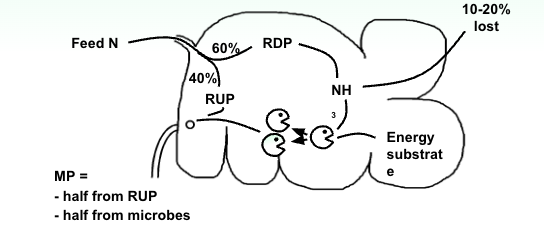
Feeding strategies
Growing and finishing market animals
- emphasize maximum production and short-term health
- feed “hot” (nutrient-dense) diets at ad libitum intake
Lactating animals and laying birds
- emphasize maximum long-term production and health
- encourage maximum energy intake during peak production
Growing replacement and companion animals
- emphasize health for sound growth
- feed a less nutrient-dense diet or restrict intake
Maintenance animals (nonpregnant adults, early pregnant)
- feed as cheaply as possible without compromising health
- overfeeding is common and is detrimental to animal health
What diet is best for an animal?
Profitability is critical in farming. As diet nutrient density increases, the response in production to an increase in the density for a nutrient diminishes and eventually plateaus.
However, the higher nutrient density diet is probably more expensive so profitability will decrease as production plateaus. The target nutrient density in balancing diets will depend on feed availability and prices and product value. For companion animals, there is no product but feed price still matters.
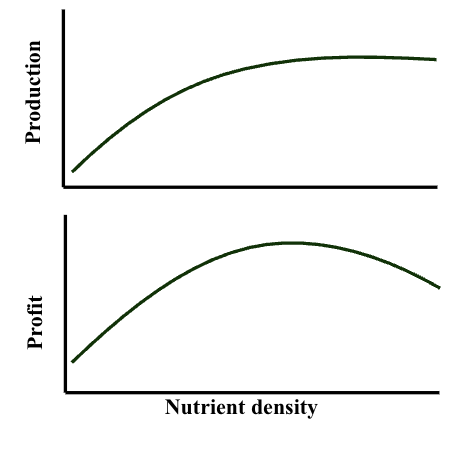
Nutrient responses and implications for groups
Group-fed animals are all fed the same diet, but the best diet is not the same for each individual.
The risks of overfeeding and underfeeding each nutrient on health, production, and profit responses must be considered.
What should be the target?
Energy: 50th percentile
Protein: 80th percentile
Minerals/vitamins: 90th %
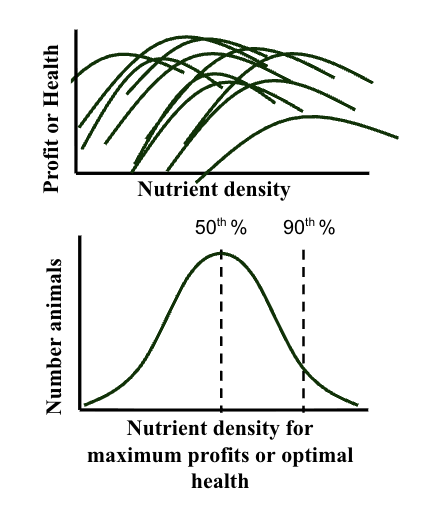
Subsampling a sample – if a sample is not representative of the whole, it is worse than no sample at all
NEVER SHAKE a handful of forage as you transfer it
To subsample, do “Quartering and Sampling”
Quartering and Sampling
Dump sample on top of large sheet (plastic is best.)
Mix by lifting alternate edges
Divide sample into 4 quarters
Remove everything from 2 opposite quarters
Repeat steps 1-4 until desired sample size is achieved
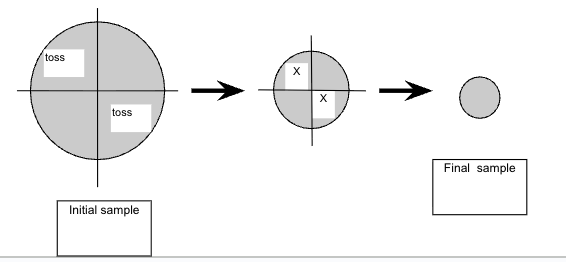
Quality Diets
1. Start with quality feedstuffs
2. Store feeds properly
3. Balance for realistic goals and include feeds that are practical
4. Consider diet complexity
5. Communication is important between the nutritionist and the feeder
6. Feed mixing: Goal is to have thorough, uniform mix
7. Proper use and withdrawal of feed additives/drugs
8. Keep good records and actively pursue quality control
Start with quality feedstuff
Homegrown feeds: quality control is key so monitor quality in the field, harvest at the right time, analyze it
Commodity feeds: quality control is key so pay attention to what you are getting, analyze sometime
ex: soyhulls, cottonseed, corn gluten meal
Commercial feeds; buy from a reputable company, understand how to read a feed tag label
Store feed properly
control moisture, temperature, access by rodents or birds
limit time of storage.
Balance for realistic goals and include feeds that are practical
Some feeds require special handling
4. Consider diet complexity
more feeds means less variability from changes in one feed
more feeds means more mistakes
simpler is usually better
5. Communication is important between the nutritionist and the feeder
a. Three diets for any animal:
1) diet on paper
2) diet actually fed
3) diet actually consumed
b. Pelleting feeds helps ensure the diet fed is diet consumed (prevents sorting).
c. Computerized systems help ensure diet on paper is diet fed.
6. Feed mixing: Goal is to have thorough, uniform mix
Proper mixing techniques vary with type of mixing equipment
a. order of ingredients (follow manufacturer’s recommendation)
Example: Protein sources → Supplements → Grains → Liquids
Roughages last, although sometimes might start with some
b. minimum inclusion rates: usually 20 to 40 lb / ton
c. mixing time for good equipment: usually 5 to 10 minutes
d. maintain equipment in good condition
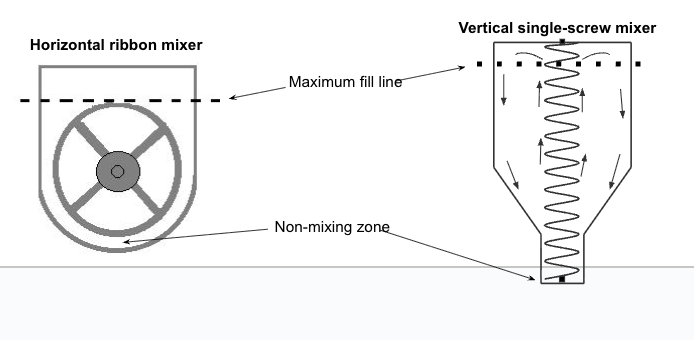
7. Proper use and withdrawal of feed additives/drugs
Ex: discontinue use 7 days prior to slaughter
8. Keep good records and actively pursue quality control
Good managers
Monitor responses in intake and production, estimate energy intake
Observe animals closely